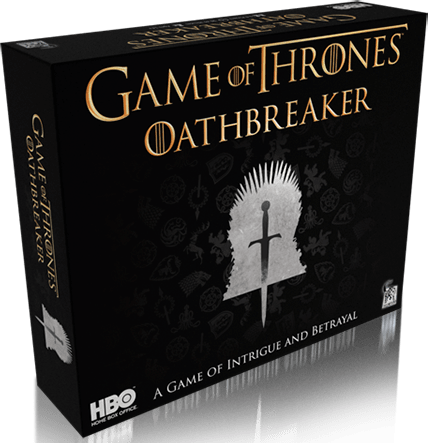Publisher: Dire Wolf Digital
Age: 14+
Players: 5-8
Game Length: 30-45 minutes
MSRP: $35
When you play the game of thrones you win or you die, but when you play Game of Thrones: Oathbreaker, everyone has a great time. Game of Thrones: Oathbreaker is a social deduction and bluffing game for large groups of five to eight players that builds upon the successful game mechanics of other social card games. The Game of Thrones theme fits perfectly as players hide their loyalties, accuse their neighbors, and ultimately serve their own personal ambitions.
Chaos is a Ladder
In Oathbreaker one player plays as the king (or queen) of the realm, while the rest are nobles vying for control. Nobles are secretly dealt cards to determine if they are a loyalist or conspirator. Loyalists need order to be higher on the score track while conspirators are all about sowing chaos. In addition, each player will have a secret personal ambition card, dictating a certain amount of honor, power, or wealth they need to accumulate to win the titular game of thrones.
Every other round nobles play cards face down to complete randomly drawn missions. They’ll need to match the correct symbols on the mission card if they want the mission to succeed and raise Order. Or they could secretly play sabotage cards to tank the mission, ensuring the rise of chaos. Conspirators will need to cleverly hide their motives, as the king player then bestows decree cards on the nobles. Favors offer boons and bonuses while Suspicions do just the opposite. This creates an interesting incentive to keep motives and actions hidden throughout the game as players compete for the king’s favor.
The hidden traitor mechanic has been used in many modern social card games from Ultimate Werewolf to The Resistance. Having a dedicated king player sets Oathbreaker apart, creating a uniquely asymmetrical experience. The king, who is always obviously on Team Loyalist, needs to pay careful attention to how their fellow players are using their character powers and where they play their cards. It’s a completely different experience compared to playing as one of the nobles.
![]()
The components are impressive and high-quality, particularly the fold out score board depicting the map of Westeros and the nice chunky sigil coins for each house. The character player boards and mission cards are modeled directly after the HBO series. Familiar faces like Jon Snow, Melisandre, and Cersei Lannister each have their own unique ability that often directly involves other nobles, like Margaery Tyrell’s Wedding Pact allowing her and another noble to draw two cards.
The mission cards depict major and minor scenes from the TV series, such as the fight between The Red Viper and The Mountain, Arya’s assassin training, and the Battle of Blackwater Bay. A total of 33 over-sized mission cards ensures a nice amount of replayability in each game.
The only real complaint about Oathbreaker is the hefty player requirement. Since one player always needs to play as the king, Oathbreaker only works with higher player counts of at least five players (with eight players requiring two king players). In all but six player games a hidden Agent mechanic is used to even the playing field between conspirators and loyalists, and can often serve as an anticlimactic ending that pushes one side or the other to victory.
 The Rating
The Rating
Oathbreaker has a recommended age of 14+. Social deduction games can be difficult to grasp for kids and tweens. Players need to be comfortable and somewhat proficient in lying, deflection, and deception. And while the game itself nor the scenes depicted are objectionable, the Game of Thrones HBO series has a very strong TV-MA rating.
The Takeaway
Party games are often light on strategy in order to engage more players, but Oathbreaker expertly threads the needle between complex strategy and deception and hilarious hi-jinks. Even non-Game of Thrones fans could appreciate the simple but effective gameplay. Oathbreaker could very well replace many of the biggest social intrigue games on your game shelf and should be the first game you pull out for larger gatherings on game night.


